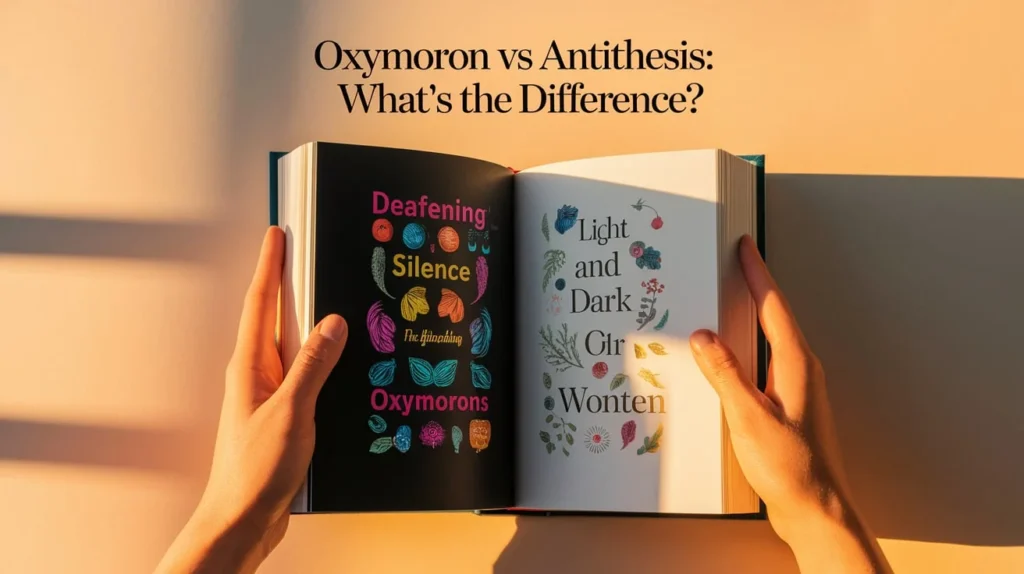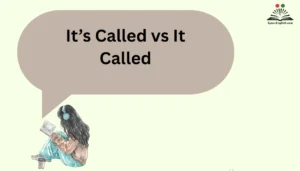When it comes to language, certain literary devices can make a huge difference in the way we communicate. Among these, oxymorons vs antitheses stand out due to their ability to express contrast, irony, and deeper meanings. But how do these devices differ? And more importantly, how can you use them effectively in your own writing?
In this article, we’ll break down the key differences between oxymoron vs antithesis, providing you with examples, practical tips, and a deeper understanding of how to harness their power.
The Power of Contrast in Language
Language is full of nuances, and literary devices like oxymoron and antithesis help bring out those subtleties. At first glance, these two concepts might seem similar, as both deal with opposing ideas. However, they serve different purposes and are used in unique ways to convey meaning. Whether you’re writing poetry, delivering a speech, or just trying to make your writing more impactful, understanding the difference between these two devices will help you use them to their fullest potential.
In this post, we’ll cover:
- The definition of oxymoron and antithesis
- Real-world examples of each
- How to use them effectively
- Common mistakes to avoid
- Where and when to use them
By the end, you’ll have a clear understanding of both oxymoron and antithesis, and how to apply them in your own writing to create a stronger impact.
What is an Oxymoron?
An oxymoron is a figure of speech that combines two contradictory or opposing words to create a unique meaning. This device often works to express irony, create dramatic effect, or highlight the complexity of a situation. It can also be used humorously or poetically, as it pairs opposite ideas in a way that feels unexpected yet meaningful.
For example, the phrase “deafening silence” brings together two contradictory ideas—deafening (extremely loud) and silence (the absence of sound). The result is a paradox that suggests a silence so deep that it almost seems overwhelming.
Examples of Oxymoron:
- Deafening silence
- Bitter sweet
- Living dead
- Jumbo shrimp
- Act naturally
- Only option
- Original copy
- Awfully good
Examples of Oxymoron
Oxymorons are used frequently in both casual speech and literary works. Below are some common examples, along with explanations of their meaning and impact:
- Bitter sweet: This describes a feeling that’s both happy and sad at the same time. Think of saying goodbye to someone you love but knowing it’s for their best.
- Living dead: Used in zombie or horror genres, this phrase combines life and death, suggesting a state where something exists but isn’t truly alive.
- Jumbo shrimp: A humorous contradiction, this phrase highlights the paradox of something being both large (jumbo) and small (shrimp).
- Deafening silence: A classic oxymoron, it’s often used to describe a silence that’s so heavy it almost feels like it’s making a sound.
- Only option: While “only” implies a lack of choice, “option” suggests possibilities. Together, they express a situation where choice is an illusion.
Origins of Oxymoron
The term oxymoron comes from the Greek words “oxys” meaning sharp and “moros” meaning foolish or dull. The combination of these two words mirrors the nature of the oxymoron itself: two seemingly contradictory words or ideas that, when put together, create a striking effect.
This device has been used for centuries, appearing in works by authors like Shakespeare, who used it to express complex emotions and contradictions. For example, in Romeo and Juliet, Juliet uses the oxymoron “feather of lead” to describe the contradictory feelings she has toward love.
What is Antithesis?
While an oxymoron pairs two opposing words, antithesis is a rhetorical device that places two contrasting ideas or statements side by side. It’s typically used in longer expressions or sentences, rather than just individual words. The purpose of antithesis is to highlight the stark contrast between the two ideas and make the difference more striking.
An example of antithesis would be the famous line from A Tale of Two Cities by Charles Dickens: “It was the best of times, it was the worst of times.” Here, the two contrasting ideas (best and worst) are placed side by side to emphasize the extremes of the situation.
Examples of Antithesis:
- “It was the best of times, it was the worst of times.”
- “Give me liberty, or give me death.” – Patrick Henry
- “To be, or not to be, that is the question.” – William Shakespeare
- “Better to reign in Hell than serve in Heaven.” – John Milton
- “Speech is silver, but silence is golden.”
Examples of Antithesis
Antitheses are widely used in literature, speeches, and everyday language to emphasize contrast and highlight contradictions. Below are some examples, along with their intended effects:
- “Give me liberty, or give me death.”: This quote from Patrick Henry’s speech highlights the drastic choice between freedom and death, making it a powerful rhetorical device.
- “To be, or not to be, that is the question.”: In Shakespeare’s Hamlet, this famous line emphasizes the contrast between life and death, forcing the reader to consider both extremes.
- “Speech is silver, but silence is golden.”: This maxim contrasts the value of speech with the value of silence, suggesting that sometimes silence holds more worth.
- “Better to reign in Hell than serve in Heaven.”: Milton’s line from Paradise Lost emphasizes the tension between autonomy and servitude, both in a divine and human context.
Origins of Antithesis
Antithesis originates from Greek rhetoric, where it was used to highlight opposing ideas for dramatic effect. The word itself comes from “anti” (against) and “thesis” (position), making it a device that places opposing concepts in direct contrast to emphasize their difference.
The use of antithesis can be traced back to ancient Greek orators like Aristotle, who recognized the power of contrasting ideas in persuasive speech. Antithesis became a favorite tool of writers throughout history, especially in works that sought to explore complex themes, such as love and hate, life and death, or freedom and oppression.
Oxymoron vs Antithesis: The Differences
While both oxymoron and antithesis deal with contrasts, they are fundamentally different in how they function:
| Feature | Oxymoron | Antithesis |
| Structure | Pairs two contradictory words or phrases. | Places two opposing ideas or statements side by side. |
| Purpose | Highlights paradox, irony, or surprise. | Emphasizes the stark contrast between two ideas or concepts. |
| Example | “Jumbo shrimp” | “It was the best of times, it was the worst of times.” |
| Usage | Often used for poetic or dramatic effect. | Common in speeches, literature, and persuasive writing. |
While oxymorons are typically used for dramatic emphasis within a single phrase or sentence, antitheses are longer constructs that highlight opposing ideas within a sentence or paragraph. Both devices work to capture attention and provoke thought, but they do so in different ways.
How to Use Oxymoron and Antithesis in Sentences
Using oxymorons and antitheses in your writing can elevate the impact of your words, making them more engaging and thought-provoking. Here’s how you can effectively use each device:
- Oxymoron:
- Use it to convey complexity: When you want to express something paradoxical or complicated, an oxymoron can work well. For example, “A deafening silence” suggests an overwhelming quiet that speaks volumes.
- Create a surprise element: Oxymorons can often surprise the reader by presenting ideas that shouldn’t logically go together. For example, “bittersweet” is a familiar oxymoron, but it evokes a depth of meaning.
- Antithesis:
- Use it for contrast: If you want to highlight two opposing ideas or viewpoints, antithesis is an effective tool. For example, “Success is not final, failure is not fatal; it is the courage to continue that counts.”
- Highlight balance: Antithesis often creates a balanced structure, which can give a sense of symmetry to your writing.
Common Mistakes to Avoid When Using Oxymoron and Antithesis
- Overuse: Too many oxymorons or antitheses can overwhelm your reader. Use them sparingly for maximum impact.
- Misusing oxymoron: Don’t confuse oxymorons with other rhetorical devices like paradox or irony.
- Inconsistent tone: If your writing is serious or scholarly, overusing oxymorons or antitheses might break the flow.
Tips for Avoiding These Mistakes
- Be intentional: Ensure that every use of an oxymoron or antithesis adds meaning or enhances your argument.
- Choose your moments: Use these devices when you want to highlight contrast or emphasize an irony.
- Balance: Make sure that your use of these devices fits the tone of your writing.
Where to Use Oxymoron and Antithesis
- Literature: Both devices are staples in literature for conveying deep meaning and emotional conflict.
- Speeches: Public speakers use antithesis to create memorable and impactful statements.
- Creative Writing: Authors often use oxymorons to express paradoxical emotions or concepts.
Where Not to Use Oxymoron and Antithesis
- Technical Writing: In professional or academic writing, clarity is key, and these devices may confuse the message.
- Casual Conversations: While they can be fun, using oxymorons and antitheses too frequently in casual speech can make you sound pretentious.
Conclusion
Understanding the difference between oxymoron and antithesis can significantly enhance your writing and speech. Whether you want to highlight contradictions, express irony, or simply make your language more vivid, these devices are powerful tools.
By using them thoughtfully, you can deepen your message and engage your audience in a more meaningful way. Remember, oxymorons work best when paired to create surprising contrasts, while antitheses are effective when placing opposing ideas side by side for emphasis.
With these insights in hand, you’ll be better equipped to wield these literary devices to their fullest potential!

Emma Brooke is a passionate English educator, writer, and language enthusiast with over a decade of experience helping learners master the nuances of the English language. At SynoEnglish, she blends practical grammar advice with real-world communication tips to make English easier, clearer, and more enjoyable for readers of all levels.



